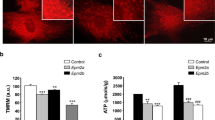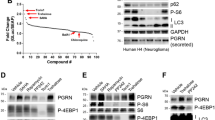Abstract
Lafora disease (LD, OMIM 254780) is a rare fatal neurodegenerative disorder that usually occurs during childhood with generalized tonic-clonic seizures, myoclonus, absences, drop attacks, or visual seizures. Unfortunately, at present, available treatments are only palliatives and no curative drugs are available yet. The hallmark of the disease is the accumulation of insoluble polyglucosan inclusions, called Lafora bodies (LBs), within the neurons but also in heart, muscle, and liver cells. Mouse models lacking functional EPM2A or EPM2B genes (the two major loci related to the disease) recapitulate the Lafora disease phenotype: they accumulate polyglucosan inclusions, show signs of neurodegeneration, and have a dysregulation of protein clearance and endoplasmic reticulum stress response. In this study, we have subjected a mouse model of LD (Epm2b−/−) to different pharmacological interventions aimed to alleviate protein clearance and endoplasmic reticulum stress. We have used two chemical chaperones, trehalose and 4-phenylbutyric acid. In addition, we have used metformin, an activator of AMP-activated protein kinase (AMPK), as it has a recognized neuroprotective role in other neurodegenerative diseases. Here, we show that treatment with 4-phenylbutyric acid or metformin decreases the accumulation of Lafora bodies and polyubiquitin protein aggregates in the brain of treated animals. 4-Phenylbutyric acid and metformin also diminish neurodegeneration (measured in terms of neuronal loss and reactive gliosis) and ameliorate neuropsychological tests of Epm2b−/− mice. As these compounds have good safety records and are already approved for clinical uses on different neurological pathologies, we think that the translation of our results to the clinical practice could be straightforward.









Similar content being viewed by others
Abbreviations
- AMPK:
-
AMP-activated protein kinase
- LB:
-
Lafora bodies
- LD:
-
Lafora disease
- 4-PBA:
-
4-Phenylbutyric acid
- SDS-PAGE:
-
Sodium dodecyl sulfate polyacrylamide gel electrophoresis
References
Delgado-Escueta AV (2007) Advances in Lafora progressive myoclonus epilepsy. Curr Neurol Neurosci Rep 7:428–433
Monaghan TS, Delanty N (2010) Lafora disease: epidemiology, pathophysiology and management. CNS Drugs 24:549–561
Minassian BA, Lee JR, Herbrick JA, Huizenga J, Soder S et al (1998) Mutations in a gene encoding a novel protein tyrosine phosphatase cause progressive myoclonus epilepsy. Nat Genet 20:171–174
Serratosa JM, Gomez-Garre P, Gallardo ME, Anta B, de Bernabe DB et al (1999) A novel protein tyrosine phosphatase gene is mutated in progressive myoclonus epilepsy of the Lafora type (EPM2). Hum Mol Genet 8:345–352
Chan EM, Young EJ, Ianzano L, Munteanu I, Zhao X et al (2003) Mutations in NHLRC1 cause progressive myoclonus epilepsy. Nat Genet 35:125–127
Lohi H, Ianzano L, Zhao XC, Chan EM, Turnbull J et al (2005) Novel glycogen synthase kinase 3 and ubiquitination pathways in progressive myoclonus epilepsy. Hum Mol Genet 14:2727–2736
Vilchez D, Ros S, Cifuentes D, Pujadas L, Valles J et al (2007) Mechanism suppressing glycogen synthesis in neurons and its demise in progressive myoclonus epilepsy. Nat Neurosci 10:1407–1413
Solaz-Fuster MC, Gimeno-Alcaniz JV, Ros S, Fernandez-Sanchez ME, Garcia-Fojeda B et al (2008) Regulation of glycogen synthesis by the laforin-malin complex is modulated by the AMP-activated protein kinase pathway. Hum Mol Genet 17:667–678
Liu Y, Wang Y, Wu C, Liu Y, Zheng P (2009) Deletions and missense mutations of EPM2A exacerbate unfolded protein response and apoptosis of neuronal cells induced by endoplasm reticulum stress. Hum Mol Genet 18:2622–2631
Vernia S, Rubio T, Heredia M, Rodriguez de Cordoba S, Sanz P (2009) Increased endoplasmic reticulum stress and decreased proteasomal function in Lafora disease models lacking the phosphatase laforin. PLoS One 4:e5907
Zeng L, Wang Y, Baba O, Zheng P, Liu Y (2012) Laforin is required for the functional activation of malin in endoplasmic reticulum stress resistance in neuronal cells. FEBS J 279:2467–2478
Rao SN, Maity R, Sharma J, Dey P, Shankar SK et al (2010) Sequestration of chaperones and proteasome into Lafora bodies and proteasomal dysfunction induced by Lafora disease-associated mutations of malin. Hum Mol Genet 19:4726–4734
Aguado C, Sarkar S, Korolchuk VI, Criado O, Vernia S et al (2010) Laforin, the most common protein mutated in Lafora disease, regulates autophagy. Hum Mol Genet 19:2867–2876
Criado O, Aguado C, Gayarre J, Duran-Trio L, Garcia-Cabrero AM et al (2012) Lafora bodies and neurological defects in malin-deficient mice correlate with impaired autophagy. Hum Mol Genet 21:1521–1533
Hetz C, Mollereau B (2014) Disturbance of endoplasmic reticulum proteostasis in neurodegenerative diseases. Nat Rev Neurosci 15:233–249
Sinadinos C, Valles-Ortega J, Boulan L, Solsona E, Tevy MF et al (2014) Neuronal glycogen synthesis contributes to physiological aging. Aging Cell 13:935–945
Ricobaraza A, Cuadrado-Tejedor M, Perez-Mediavilla A, Frechilla D, Del Rio J et al (2009) Phenylbutyrate ameliorates cognitive deficit and reduces tau pathology in an Alzheimer’s disease mouse model. Neuropsychopharmacology 34:1721–1732
Wiley JC, Meabon JS, Frankowski H, Smith EA, Schecterson LC et al (2010) Phenylbutyric acid rescues endoplasmic reticulum stress-induced suppression of APP proteolysis and prevents apoptosis in neuronal cells. PLoS One 5:e9135
Zhou W, Bercury K, Cummiskey J, Luong N, Lebin J et al (2011) Phenylbutyrate up-regulates the DJ-1 protein and protects neurons in cell culture and in animal models of Parkinson disease. J Biol Chem 286:14941–14951
Tanaka M, Machida Y, Niu S, Ikeda T, Jana NR et al (2004) Trehalose alleviates polyglutamine-mediated pathology in a mouse model of Huntington disease. Nat Med 10:148–154
Chen Q, Haddad GG (2004) Role of trehalose phosphate synthase and trehalose during hypoxia: from flies to mammals. J Exp Biol 207:3125–3129
Hardie DG, Ross FA, Hawley SA (2012) AMPK: a nutrient and energy sensor that maintains energy homeostasis. Nat Rev Mol Cell Biol 13:251–262
Carling D, Thornton C, Woods A, Sanders MJ (2012) AMP-activated protein kinase: new regulation, new roles? Biochem J 445:11–27
Poels J, Spasic MR, Callaerts P, Norga KK (2009) Expanding roles for AMP-activated protein kinase in neuronal survival and autophagy. Bioessays 31:944–952
Han Y, Xie N, Cao L, Zhao X, Liu X et al (2011) Adenosine monophosphate-activated protein kinase and peroxisome proliferator-activated receptor gamma coactivator 1alpha signaling provides neuroprotection in status epilepticus in rats. Neurosci Lett 500:133–138
Dulovic M, Jovanovic M, Xilouri M, Stefanis L, Harhaji-Trajkovic L et al (2014) The protective role of AMP-activated protein kinase in alpha-synuclein neurotoxicity in vitro. Neurobiol Dis 63:1–11
Ashabi G, Khodagholi F, Khalaj L, Goudarzvand M, Nasiri M (2014) Activation of AMP-activated protein kinase by metformin protects against global cerebral ischemia in male rats: interference of AMPK/PGC-1alpha pathway. Metab Brain Dis 29:47–58
Steru L, Chermat R, Thierry B, Simon P (1985) The tail suspension test: a new method for screening antidepressants in mice. Psychopharmacology (Berl) 85:367–370
Ogawa N, Hirose Y, Ohara S, Ono T, Watanabe Y (1985) A simple quantitative bradykinesia test in MPTP-treated mice. Res Commun Chem Pathol Pharmacol 50:435–441
Stanford SC (2007) The Open Field Test: reinventing the wheel. J Psychopharmacol 21:134–135
Luong TN, Carlisle HJ, Southwell A, Patterson PH (2011) Assessment of motor balance and coordination in mice using the balance beam. J Vis Exp 49:2376
R-Core-Team (2014) A language and environment for statistical computing. Foundation for Statistical Computing http://www.R-project.org/
Valles-Ortega J, Duran J, Garcia-Rocha M, Bosch C, Saez I et al (2011) Neurodegeneration and functional impairments associated with glycogen synthase accumulation in a mouse model of Lafora disease. EMBO Mol Med 3:667–681
Ortolano S, Vieitez I, Agis-Balboa RC, Spuch C (2014) Loss of GABAergic cortical neurons underlies the neuropathology of Lafora disease. Mol Brain 7:7
Turnbull J, DePaoli-Roach AA, Zhao X, Cortez MA, Pencea N et al (2011) PTG depletion removes Lafora bodies and rescues the fatal epilepsy of Lafora disease. PLoS Genet 7:e1002037
Pederson BA, Turnbull J, Epp JR, Weaver SA, Zhao X et al (2013) Inhibiting glycogen synthesis prevents Lafora disease in a mouse model. Ann Neurol 74:297–300
Turnbull J, Epp JR, Goldsmith D, Zhao X, Pencea N et al (2014) PTG protein depletion rescues malin-deficient Lafora disease in mouse. Ann Neurol 75:442–446
Duran J, Gruart A, Garcia-Rocha M, Delgado-Garcia JM, Guinovart JJ (2014) Glycogen accumulation underlies neurodegeneration and autophagy impairment in Lafora disease. Hum Mol Genet 23:3147–3156
Carling D, Hardie DG (1989) The substrate and sequence specificity of the AMP-activated protein kinase. Phosphorylation of glycogen synthase and phosphorylase kinase. Biochim Biophys Acta 1012:81–86
Tagliabracci VS, Girard JM, Segvich D, Meyer C, Turnbull J et al (2008) Abnormal metabolism of glycogen phosphate as a cause for Lafora disease. J Biol Chem 283:33816–33825
DePaoli-Roach AA, Tagliabracci VS, Segvich DM, Meyer CM, Irimia JM et al (2010) Genetic depletion of the malin E3 ubiquitin ligase in mice leads to Lafora bodies and the accumulation of insoluble laforin. J Biol Chem 285:25372–25381
Turnbull J, Wang P, Girard JM, Ruggieri A, Wang TJ et al (2010) Glycogen hyperphosphorylation underlies Lafora body formation. Ann Neurol 68:925–933
Acknowledgments
We want to thank Carla Rubio-Villena and Maria Adelaida Garcia-Gimeno for their help in the analyses of glycogen-related enzymes. This work was supported by grants from the Spanish Ministry of Education and Science (SAF2011-27442), Fundació La Marato de TV3 (ref. 100130), and an ACCI2012 action from CIBERER. A.B.. holds a postdoctoral fellowship from the Program “Junta para la Ampliación de Estudios” (JAE-Doc) co-funded by the European Social Fund (ESF).
Author information
Authors and Affiliations
Corresponding author
Rights and permissions
About this article
Cite this article
Berthier, A., Payá, M., García-Cabrero, A.M. et al. Pharmacological Interventions to Ameliorate Neuropathological Symptoms in a Mouse Model of Lafora Disease. Mol Neurobiol 53, 1296–1309 (2016). https://doi.org/10.1007/s12035-015-9091-8
Received:
Accepted:
Published:
Issue Date:
DOI: https://doi.org/10.1007/s12035-015-9091-8




